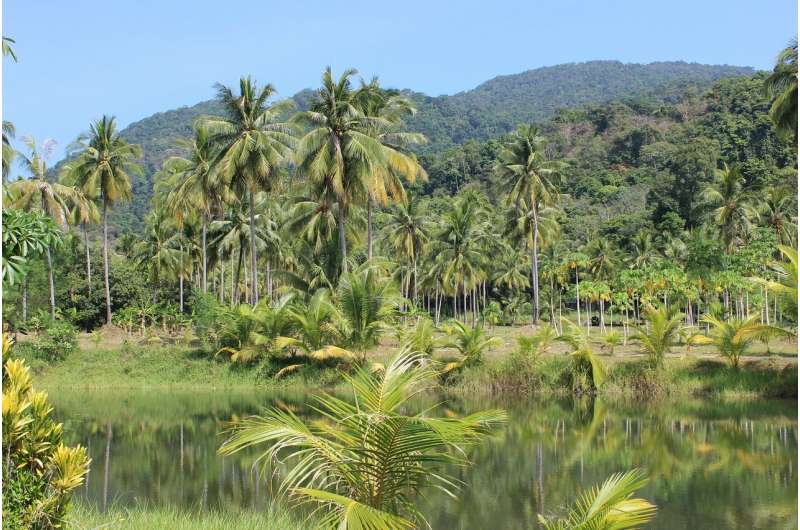Amazon forest can be trained by higher rainfall variability

The Amazon rainforest has evolved over millions of years and even through ice ages. Yet today, human influences and global climate change put this huge ecosystem at risk of large-scale dieback—with major consequences for its capability as a global CO2 sink. New research published in Nature Geoscience now reveals a key player in shaping the resilience of the Amazon, and finds that regions with generally higher rainfall variability are more resilient to current and future climate disturbances. However, despite this "training effect," the Amazon rainforest might not be able to keep up with the pace of ongoing climate change, the study shows.
"Considering the vital importance of the Amazon rainforest for our climate and biodiversity, it is astounding how much we still don't know about its ability to adapt to changing environments through the ages," lead author Catrin Ciemer from the Potsdam Institute for Climate Impact Research (PIK) says. With ongoing global warming, there will probably be a higher frequency of droughts in the Amazon basin, which might increase tree mortality and fire risks. "We set to uncover a mechanism that increases the ecosystem's resilience. It turns out that regions of the Amazon rainforest that were exposed to more variable rainfall conditions seem to be equipped with a higher ability to resist to and recover from climatic disturbances."
Mapping out more vulnerable regions by combining nonlinear dynamics analysis with state-of-the-art observations
Covering about two thirds of South America, the Amazon rainforest is the largest continuous rainforest on earth, with an unparalleled biodiversity of plants and animals. Vast amounts of carbon are stored in the forest's biomass, making the Amazon rainforest the most important terrestrial CO2 sink. Based on precipitation and tree cover data in the Brazilian Amazon basin, the researchers constructed so-called potential landscapes to characterize the rainfall regimes where the ecosystems remain stable, and identify critical thresholds beyond which vegetation might switch from forest to savanna.
"The detection of this so far hidden dynamic stability behaviour was mainly based on combining modern techniques of nonlinear dynamics analysis with state-of-the-art observations," says Jürgen Kurths, co-author and co-chair of the PIK research department for Complexity Science. "We develop and apply advanced mathematical approaches to investigate real-world problems that have tremendous impacts on people all over the planet—the Amazon rainforest is of great relevance for global carbon and water cycles and interacts with a number of other critical elements of the Earth system," explains co-author Marina Hirota from the Federal University of Santa Catarina in Brazil.
"Our approach allows us to map out which regions are comparably more vulnerable to future precipitation changes," says co-author Ricarda Winkelmann, co-leader of PIK FutureLab on "Earth Resilience in the Anthropocene." Less 'trained' regions which aren't used to frequent changes in rainfall will be especially affected. "Our analysis shows that in a business-as-usual greenhouse gas emission scenario, a large coherent region in the southern Amazon might be at risk of transitioning from forest to savanna." The question is, how much change can the Amazon forest cope with? It turns out that while the Amazon is an ancient ecosystem with the ability to adapt over long time-scales, it might not be able to keep up with the pace of ongoing climate change.
Current forest policy of Brazil can make resilience obsolete: "No way to adapt to a chainsaw"
Of course, climate change is not the only major stressor of the Amazon rainforest. "Humans interfere on a yet more immediate level with the Amazon," says Niklas Boers, coauthor of the study. Large-scale forest clearance, primarily to convert land into pasture for cattle and cropland, is already a serious threat to the rainforest. Even if some regions in the Amazon are better equipped to cope with climate change due to the training effect, the current forest policies of Brazil and other countries can make any resilience capability of the rainforest obsolete. "With or without resilience to climate disturbances, there is no way to adapt to a chainsaw."
More information: Catrin Ciemer et al, Higher resilience to climatic disturbances in tropical vegetation exposed to more variable rainfall, Nature Geoscience (2019). DOI: 10.1038/s41561-019-0312-z
Journal information: Nature Geoscience
Provided by Potsdam Institute for Climate Impact Research















